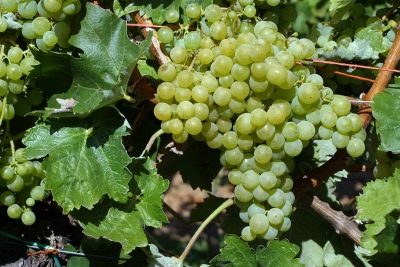
- Authors: Spain
- Appointment: technical
- Berry color: White
- Taste: harmonious
- Ripening period: average
- Frost resistance, ° C: -22
- Name synonyms: Airen, Ayden, Layren, Manchega, Valdepener, Blank de Valdepenians, Blank Machengo, El Biod
- Flower type: bisexual
- Density of the bunch: medium
- Skin: thin
Grapes are commonly associated with warm climates. But in fact, he can grow in the Urals and in the Moscow region, you just need to provide him with proper care. Of the technical varieties, Ayren is considered one of the most demanded.
Breeding history
The first records of this grape appeared in the 17th century. Then, as now, the described variety was used for the production of wine. Although Ayren did not possess any special taste, he spread first across Spain, and then around the world.
Description
The described grape variety is classified as technical. The bushes have strong growth, therefore they require constant pruning. The vine is developing well.
Ayren's foliage has three lobes with a medium dissection. If you look at the petiole, then there is a depression that resembles a vault. There is a small fluff on the back side.
Ripening period
The ripening period for the Ayren grape variety is average.
Bunches
The shape of the bunches can be characterized as branched with an average density of berries.
Berries
Fruits are white with thin skin. The grapes are round. Medium-dense pulp inside.
Taste
The taste is unambiguously harmonious, that is how it is characterized.
Yield
Ayren is boldly classified as a high-yielding variety.


Growing features
Before planting the vine, it must be immersed in a bucket of water for at least 6 hours. In no case do not allow the roots of the vine to dry out - this is very important! If several hundred vines are planted, cover the not yet planted with a damp cloth or something similar.
Landing
Studies have shown that the vine germinates well without fertilization in the planting pit. They will be required when it reaches a length of 10 cm. Adding fertilizer directly to the planting hole can easily damage the roots, so you should be careful. It is best to fertilize the soil in the fall before planting.
Make a planting hole fairly large to accommodate the roots of the cutting. Do not cut or remove them if they do not fit, it is better to enlarge the hole. The more roots, the more chances that the vine will take root successfully. Continuously add water to the pit while planting. This way you can easily make sure that no air pockets are formed near the roots.

Pollination
Flowers of both sexes grow on the vine, which means that this variety is self-pollinated.
Pruning
Prune the vine in early spring before new leaf buds appear. Then, while the new shoots are still young and flexible, you can train them to grow on a trellis. With good maintenance and pruning, the bush will remain compact and beautiful in a small space.
Some gardeners are creative and choose to grow vines along the wall, trellis. Branches should not be pruned after spring foliage has emerged, as young flowers that will later become grapes can be easily pruned.

Watering
Before planting the vine, water the planting hole thoroughly and make sure the water penetrates deep into the sidewalls. Water the bush once a week for a month after planting.


Top dressing
When growing grapes, there must be a good soil base for it to take root and grow quickly. To do this, you need to periodically fertilize it. Manure from cows and horses is a good option, but it must be rotted, and it is not poured onto the roots, otherwise it is very easy to burn them.
There are also ready-made mineral complex mixtures in stores. It is rational to use them in spring and summer.
A good top dressing is a woody vine, chicken droppings.
Frost resistance and the need for shelter
Frost resistance at -22 degrees is considered average. When planting vines in a region where the climate is temperate, and in winter the temperature can drop below this indicator, it is imperative to use a shelter. The cheapest option is spruce branches, the expensive one is agrotechnical material.

Diseases and pests
To protect the variety from pests, special preparations are used - insecticides. Fungicides help fight diseases. But besides them, garlic infusion and copper sulfate have long been used in gardening.

If the grapes are exposed to any disease or insect, this is always reflected in its appearance.
Storage
The grapes are not stored for a long time, therefore, immediately after harvesting, they are sent to the production of wine.











































































